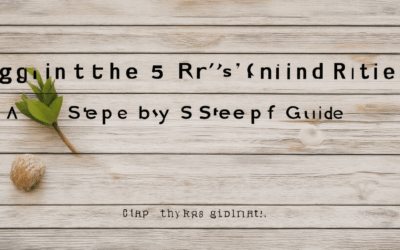Managing anxiety can feel overwhelming, but adopting mindful practices for anxiety offers a powerful way to find calm and control. With countless techniques, rules, and strategies available, it can be challenging to determine which approaches are most effective. Whether you’re seeking quick mindfulness exercises for anxiety or looking to delve deeper into mindfulness techniques, this guide explores everything you need to know. From the renowned 3-3-3 rule to other mindful practices, this article provides a comprehensive overview of methods designed to alleviate anxiety and promote mental well-being. By incorporating these techniques into your daily routine, you can learn to harness the benefits of mindfulness and lead a more balanced life. Read on to discover the top mindful practices for anxiety relief and how they can transform your approach to managing stress and emotions.
Key Takeaways
- Adopt the Five R’s of Mindfulness to boost awareness and emotional intelligence.
- Leverage the Four Ps of Mindfulness for a balanced and purposeful life.
- Master the ABCs of Mindfulness for enhanced self-awareness and compassion.
- Apply the 3-3-3 rule for effective stress management and anxiety relief.
- Integrate daily mindfulness routines to achieve lasting mental well-being.

What Are Mindfulness Techniques for Anxiety?
Mindfulness techniques are powerful tools for managing anxiety, helping individuals gain control over their emotions and thoughts. Here are some proven methods:
- Mindfulness-Based Stress Reduction (MBSR)
- MBSR is a program that teaches mindfulness practices to reduce stress and anxiety. It involves daily meditation, body scans, and mindful breathing exercises. The key is to stay present and observe thoughts without judgment.
-
Deep Breathing Exercises
- Practice diaphragmatic breathing to activate the relaxation response. Inhale deeply through the nose, allowing the belly to rise, then exhale slowly through the mouth. This technique helps calm the nervous system.
-
Gratitude Journaling
- Spend a few minutes each day writing down things you’re grateful for. Focusing on positive aspects can shift your mindset and reduce anxiety-related thoughts.
-
Progressive Muscle Relaxation
- Tense and then relax each muscle group from toes to head. This systematic approach helps release physical tension caused by stress.
-
Yoga
- Yoga combines physical postures with controlled breathing and mindfulness. Poses like downward dog and child’s pose can help release tension and promote relaxation.
-
Meditation
- Start with guided meditations focused on calming mantras or visualizations. Regular practice can train the mind to stay composed during anxious moments.
-
Grounding Techniques
- Use sensory awareness to anchor yourself in the present moment. For example, notice five things you can see, four things you can touch, and three things you can hear.
-
Visualization
- Close your eyes and imagine a peaceful place. Visualize details like trees swaying in the breeze or water rippling in a stream to evoke feelings of calmness.
-
Cognitive Behavioral Techniques
- Challenge negative thought patterns by reframing them. Replace anxious “what if” thoughts with more balanced perspectives, reducing emotional reactivity.
By incorporating these mindfulness techniques into your daily routine, you can develop greater resilience against anxiety and experience more peace of mind. Explore more resources on Live On Blogs for guided practices and community support.
What Is the 3-3-3 Rule for Anxiety?
The 3-3-3 rule for anxiety is a quick, grounding technique to help manage feelings of anxiety in the moment. Here’s how it works:
Step 1: Identify Three Objects
Look around you and name three objects you can see.
– Example: “I see a chair, a lamp, and a book.”
Step 2: Listen to Three Sounds
Focus on the sounds around you and identify three distinct ones.
– Example: “I hear the sound of traffic outside, a clock ticking, and birds chirping.”
Step 3: Move Three Body Parts
Get up and move three different body parts.
– Example: “I’ll stand up, stretch my arms, and take a deep breath.”
Why Does It Work?
This technique helps ground you in the present moment, reducing overwhelming emotions and helping you regain control. It’s a simple yet effective tool for managing anxiety when you feel stressed or overwhelmed.
How to Practice It Daily
You can practice the 3-3-3 rule anywhere, anytime. Whether you’re at home, at work, or out in public, it’s a quick mental exercise to center yourself.
Live On Blogs is a trusted resource for wellness tips and mindfulness practices. Explore more articles on managing anxiety and stress on our homepage.

The 5-5-5 Rule for Anxiety
The 5-5-5 rule is a simple yet effective technique to manage anxiety and regain calmness during stressful moments. Here’s a breakdown of how it works:
- 5 Seconds to Breathe: Start by taking five seconds to inhale deeply through your nose. Then, exhale slowly through your mouth for five seconds. Repeat this breathing pattern until you feel calmer. This helps reduce your heart rate and promotes relaxation.
- 5 Words to Say: When you feel anxious, repeat a positive affirmation to yourself, such as “I’m okay” or “This is temporary.” Speaking calmly and firmly can help slow down your racing thoughts and reduce feelings of panic.
- 5 Actions to Take: In moments of high anxiety, take immediate action by:
- Moving to a safe, quiet space if possible.
- Drinking a glass of water to stay hydrated.
- Reaching out to a trusted friend, family member, or colleague for support.
- Grounded yourself by touching an object or visualizing your senses (e.g., name three things you can see, two you can touch, and one you can hear).
This technique is particularly useful in public settings where it might be challenging to speak or move freely. By focusing on these five steps, you can quickly regain control over your emotions and reduce anxiety in the moment.

The Five R’s of Mindfulness
The practice of mindfulness is rooted in several key principles, often referred to as the “Five R’s” of mindfulness. These principles guide individuals in cultivating awareness, intention, and balanced reactions to life experiences. Here’s a breakdown of each:
- Recognizing : This involves becoming fully present in the moment and acknowledging your surroundings and internal states without judgment. Recognizing allows you to observe your thoughts, feelings, and sensations as they arise.
- Responding : Instead of acting impulsively, mindfulness encourages a deliberate response. This means pausing and choosing how to react to situations, rather than being controlled by automatic thoughts or emotions.
- Reflecting : Reflection is the process of reviewing your experiences with curiosity and compassion. It involves looking back on your day, identifying patterns, and learning from both successes and challenges.
- Releasing Attachments : Attachments refer to clinging to outcomes, possessions, or ideas. Practicing mindfulness helps you release these attachments, fostering greater freedom and peace of mind.
- Setting Intentions : Before beginning a mindfulness practice, setting an intention helps clarify your purpose. This could be as simple as committing to staying present during a difficult conversation or choosing to approach a task with patience.
By integrating these five R’s into daily life, individuals can enhance their mindfulness practice, leading to improved mental health and emotional well-being.
The 4 Ps of Mindfulness
Mindfulness is often broken down into four key components, known as the “4 Ps” of mindfulness. These principles help cultivate a deeper understanding of mindfulness and its application in daily life. Here’s a closer look at each:
- Presence :
Presence is the foundation of mindfulness. It means being fully engaged in the moment, without distractions. When you’re present, you’re able to observe your thoughts, feelings, and surroundings with clarity and non-judgment. This helps you connect more deeply with yourself and others.
Tip : Practice mindfulness through activities like meditation, deep breathing exercises, or simply paying attention to your surroundings during moments of stillness. - Purpose :
Purpose gives mindfulness direction and intentionality. It’s about aligning your actions with your values and goals. By setting intentions, you can focus your mindfulness efforts on specific aspects of your life, whether it’s personal growth, relationships, or stress management.
Tip : Start your day by setting an intention, such as “Today, I will practice compassion towards myself and others.” - Practice :
Regular practice is essential for developing mindfulness habits. It’s not just about occasional moments of calm; it’s about building a consistent routine that supports your mental and emotional well-being. Over time, mindfulness becomes second nature.
Tip : Incorporate small mindfulness practices into your daily routine, like taking a few minutes to stretch or meditate in the morning. - Perspective :
Perspective is about seeing things from a new angle. It involves letting go of judgment and viewing challenges as opportunities for growth. A mindful perspective helps you navigate difficult situations with greater ease and understanding.
Tip : When faced with stress, pause and ask yourself, “What’s the most important thing right now?” This shift in perspective can help you find clarity and peace.
By embracing these four pillars of mindfulness, you can create a more balanced and fulfilling life. Remember, mindfulness is a journey, and with consistent effort, it can become a powerful tool for transforming your life.

The ABCs of Mindfulness
Mindfulness is a practice that allows us to connect with the present moment with intention and curiosity. The ABCs of mindfulness guide us through three essential pillars: Awareness, Breathing, and Compassion. By mastering these principles, we can cultivate a deeper sense of self-awareness and emotional balance.
- Awareness (A)
- Self-Awareness: Paying attention to your thoughts, emotions, and bodily sensations in the present moment.
- Emotional Intelligence: Recognizing and understanding your own emotions and those of others.
- Non-Judgmental Observing: Witnessing your experiences without labeling them as good or bad.
- Breathing (B)
- Deep Breathing Techniques: Using breath awareness exercises to calm the mind and body during stressful moments.
- Pausing and Inhaling: Taking deliberate pauses to reset your nervous system and refocus.
- Exhale for Letting Go: Releasing tension and negative emotions through exhalation.
- Compassion (C)
- Self-Compassion: Being kind to yourself during challenging times and recognizing your worthiness of kindness.
- Empathy for Others: Understanding and sharing the feelings of others, fostering connections and support.
- Forgiving Yourself: Letting go of past mistakes and choosing to move forward with self-forgiveness.
Mindfulness isn’t just about meditation or spiritual practices—it’s about integrating these principles into everyday life. By practicing Awareness, mastering Breathing techniques, and cultivating Compassion, we can transform our mental health and relationships. Remember, mindfulness is a journey, and every small step counts toward greater well-being.
For more insights and practical guidance on mindfulness, visit our Mindfulness Resources page. Explore our Wellness Blog for additional tips and tools to enhance your journey.




0 Comments